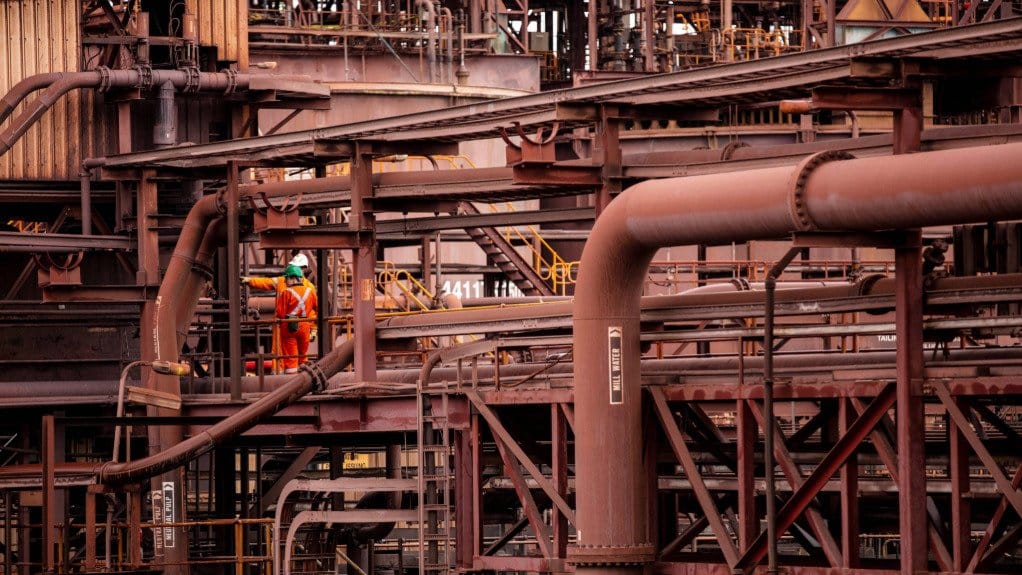Diversified mining major BHP is pumping more than A$840-million into a suite of new projects at Olympic Dam in line with a vision to turn South Australia into a copper superpower.
The investment, announced on Wednesday, covers a decline into the Southern Mine Area, a backfill delivery system, expansion of ore pass capacity with new locomotives and an extended underground electric rail system, and a new oxygen plant to lift smelter performance.
Together, the projects are designed to improve efficiency, open new mining areas and increase processing capability at Olympic Dam – the centrepiece of BHP’s Copper SA division, which also includes Prominent Hill and Carrapateena.
BHP COO Edgar Basto said the copper portfolio was central to the company’s growth agenda. “BHP is the largest producer of copper in the world, and we expect to grow our copper base from 1.7-million tonnes to around 2.5-million tonnes a year,” Basto said. “Achieving that scale requires significant copper growth, and we are fortunate to have a world-class copper province right here in South Australia to do just that.”
He added that the South Australian copper province had been performing strongly, delivering more than 300 000 t/y for the past three years. “We are progressing a series of strategic projects that will strengthen our base business and help lay the foundations for future growth.”
One of the flagship developments is the Southern Mine Area decline, which will improve access to deeper ore bodies and streamline the movement of people and equipment underground. The project is tipped to create close to 200 construction jobs.
A new backfill delivery system will pump cement paste through an underground pipe network, stabilising mined-out areas and unlocking ore that had been difficult to reach. The expansion of the underground electric rail network – from 4.85 km to more than 6 km – will be supported by six new locomotives, reducing truck haulage and cutting emissions.
At the smelter, BHP will install a new oxygen plant, increasing concentrate smelting rates from 80 t/h to 85 t/h. The additional oxygen will help strip out sulphur and iron impurities to produce 99% pure blister copper, which is then refined into cathode, gold and silver.
Copper SA president Anna Wiley said the investments reflected BHP’s long-term confidence in the region. “Copper SA is a globally significant province, and BHP’s continued investment is a clear signal of our long-term commitment to its development,” she said. “These investments strengthen the foundations for future growth – creating jobs, boosting local business opportunities, and driving greater operational efficiency across our sites.”
“We are standing at the edge of a generational opportunity to unlock transformational copper growth in South Australia. By continuing to work together across government and industry, we can capture that opportunity and achieve our shared vision to increase Australian copper production.”
Wiley said South Australia was well positioned to benefit from surging copper demand, particularly as the race to secure supply for electrification, renewable energy and data centres intensified. “Copper SA is already on the global map … we are well positioned to supply more of what the world needs.”
The investments were welcomed by both federal and state leaders. Federal Trade Minister Don Farrell said BHP had been a cornerstone of South Australia’s economy for decades. “Australia is at the forefront of the energy transition in which copper is a vital resource and by securing the continued flow of copper from Olympic Dam, BHP is ensuring South Australia’s position as a key global supplier.”
Premier Peter Malinauskas added that copper was critical to decarbonisation. “There is no zero-emissions future without reliable, accessible supplies of high-quality copper,” he said. “Copper is key to the electrification of transport fleets, for building renewable energy infrastructure, and for energy generation, distribution, and storage.”
“South Australia is at the epicentre of copper. BHP realises that, which is why it is investing billions of dollars in South Australia, to unlock the next massive copper opportunity – and it starts with massively growing Olympic Dam.”
Malinauskas reiterated his government’s ambition to double copper output, develop a two-stage smelter, and support thousands of jobs. But he also pointed to the need for more infrastructure.
“To get there, we’ll need more water, which is why the state government is working in close partnership with BHP to closely examine the Northern Water project,” he said.
Copper demand is projected to grow 70% by 2050, driven by population growth, rising living standards and the shift to renewable energy. BHP’s Copper SA produced 316 000 t last year from its 8 000-strong workforce, while exploration at Oak Dam could add a fourth mine to the portfolio.
Globally, BHP produced more than two-million tonnes of copper in the 2025 financial year – a first for the company – across its South Australian assets and the Escondida mine in Chile.



